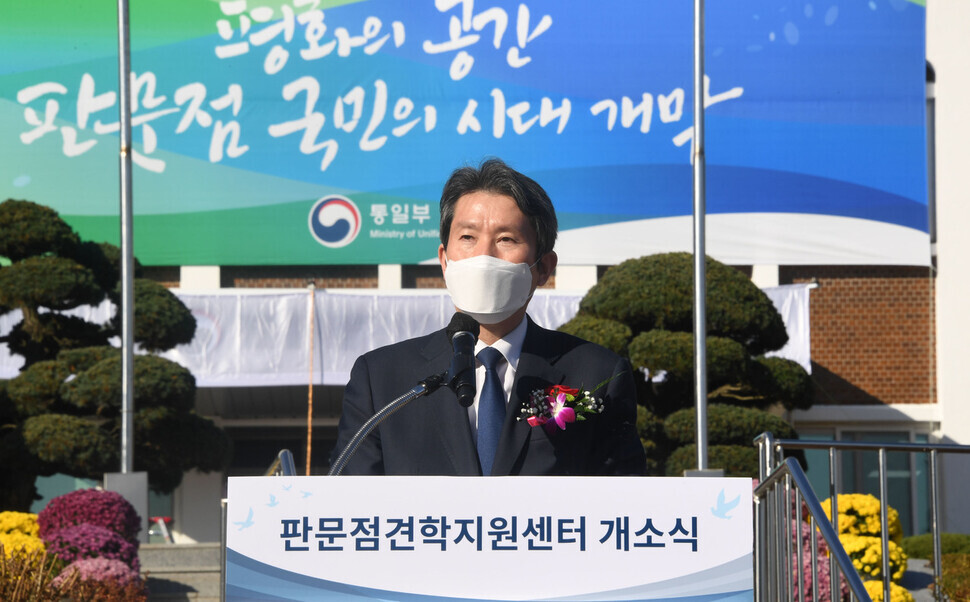hankyoreh
Links to other country sites 다른 나라 사이트 링크
Unification minister proposes “three small steps” for thawing inter-Korean relations

Tours to Panmunjom, in the DMZ between South and North Korea, have resumed.
In a speech on Nov. 4, South Korean Unification Minister Lee In-young called on South and North Koreans to build a “new time for peace” between the two sides.
“I propose three small steps toward peace here at Panmunjom with the hope that this will lead to a thaw in inter-Korean relations,” Lee said during a speech for the opening of the Panmunjom Tourist Support Center on Wednesday morning, which was scheduled to coincide with the resumption of tours.
The “three small steps” that Lee officially proposed to the North are restoring inter-Korean channels of communication, opening up Panmunjom to visits by South and North Koreans, and hosting divided family reunions at Panmunjom.
Lee observed that Panmunjom had hosted 376 inter-Korean meetings and described it as “the place where the Comprehensive Military Agreement is being preserved and implemented.”
“At this very moment, Panmunjom marks the beginning of a modest peace and is laying a hopeful foundation for the great peace that we desire,” Lee said.
Panmunjom tours were suspended in October 2019 because of an outbreak of African swine fever in Paju and other parts near the inter-Korean border. They have remained suspended since then because of the COVID-19 pandemic, which began early in 2020.
Following a trial tour on Wednesday, the tours will be opened up to the general public on Friday, Nov. 6. Until last year, Panmunjom hosted four groups of 80 tourists each day. But because of the coronavirus, the tours will be held on a smaller basis for the time being, with two groups of 40 tourists allowed each day.
Several steps were taken to make the Panmunjom tours more accessible and convenient during their year-long suspension.
First, the registration process, which was previously only open to groups of 30-40, is now available for individuals and families of up to five.
Second, the time between signing up for a tour and the actual tour has been shrunk from as long as 60 days to 14 days.
Third, all registrations will now be managed by the Panmunjom Tourist Support Center (www.panmuntour.go.kr), under the Unification Ministry. The option of signing up online makes the tours more accessible. This step was made possible by migrating offices responsible for the tours at the Ministry of National Defense and the National Intelligence Service to the Unification Ministry.
Fourth, the minimum age for the tours has been lowered from 10 to eight. That means that first graders in elementary school can now take part.
A Panmunjom tour takes visitors through a tour center at Imjingak and the guard station at the Joint Security Area and then on the grounds of Panmunjom itself.
Inside Panmunjom, tourists can look around and take snapshots of sights including the pedestrian bridge where South Korean President Moon Jae-in and North Korean leader Kim Jong-un sat down for a conversation and the House of Freedom, which hosted the first meeting in history between the leaders of South Korea, North Korea, and the US.
By Lee Je-hun, senior staff writer
Please direct comments or questions to [english@hani.co.kr]

Editorial・opinion
![[Column] Park Geun-hye déjà vu in Yoon Suk-yeol [Column] Park Geun-hye déjà vu in Yoon Suk-yeol](https://flexible.img.hani.co.kr/flexible/normal/500/300/imgdb/original/2024/0424/651713945113788.jpg) [Column] Park Geun-hye déjà vu in Yoon Suk-yeol
[Column] Park Geun-hye déjà vu in Yoon Suk-yeol![[Editorial] New weight of N. Korea’s nuclear threats makes dialogue all the more urgent [Editorial] New weight of N. Korea’s nuclear threats makes dialogue all the more urgent](https://flexible.img.hani.co.kr/flexible/normal/500/300/imgdb/original/2024/0424/7317139454662664.jpg) [Editorial] New weight of N. Korea’s nuclear threats makes dialogue all the more urgent
[Editorial] New weight of N. Korea’s nuclear threats makes dialogue all the more urgent- [Guest essay] The real reason Korea’s new right wants to dub Rhee a founding father
- [Column] ‘Choson’: Is it time we start referring to N. Korea in its own terms?
- [Editorial] Japan’s rewriting of history with Korea has gone too far
- [Column] The president’s questionable capacity for dialogue
- [Column] Are chaebol firms just pizza pies for families to divvy up as they please?
- [Column] Has Korea, too, crossed the Rubicon on China?
- [Correspondent’s column] In Japan’s alliance with US, echoes of its past alliances with UK
- [Editorial] Does Yoon think the Korean public is wrong?
Most viewed articles
- 1‘We must say no’: Seoul defense chief on Korean, USFK involvement in hypothetical Taiwan crisis
- 2Will NewJeans end up collateral damage in internal feud at K-pop juggernaut Hybe?
- 3[Column] Park Geun-hye déjà vu in Yoon Suk-yeol
- 4Why Korea shouldn’t welcome Japan’s newly beefed up defense cooperation with US
- 5Thursday to mark start of resignations by senior doctors amid standoff with government
- 6N. Korean hackers breached 10 defense contractors in South for months, police say
- 7[Guest essay] The real reason Korea’s new right wants to dub Rhee a founding father
- 8[Column] ‘Choson’: Is it time we start referring to N. Korea in its own terms?
- 9Kim Jong-un expressed ‘satisfaction’ with nuclear counterstrike drill directed at South
- 10[Editorial] New weight of N. Korea’s nuclear threats makes dialogue all the more urgent